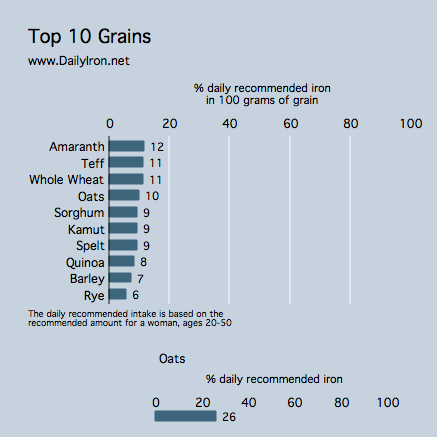This food contains 4.7 milligrams of iron per 100 grams. Grams is a measure of weight. To put 100 grams in perspective, consider alternative measures for this food:
- 1 cup equals 156 grams.
In the category of grain, we included whole grains and flours in the Top 10 list. Foods may be fortified with iron but are not included in this Top 10 list.The food tested for the particular graph below can be described more specifically as:
Oats
Read more about iron in grains or visit our iron-rich foods list.

Oats and Oatmeal: High Iron but High Iron Inhibitors
Oats and oatmeal are popular food items and, on their face, they are high in iron. However, oats, like many other grains such as spelt, rye, barley, sorghum, and kamut have substances that inhibit your absorption of iron. On this website, we recommend processes to reduce the iron inhibitors in food, such as soaking the grains in advance of eating them, fresh milling them, or making sourdough recipes. In the case of oats and oatmeal, however, these techniques are not nearly as effective.
If you are relying on grains for your dietary iron, we strongly recommend alternative high-iron grains such as amaranth, teff, and quinoa and employ the preparation techniques we recommend on this site. These grains cook up nicely as breakfast cereals and can be a good alternative to oatmeal. They may also be used in baking.
Read more of our iron rich foods tips to learn about preparing these grains and use the search function on this website to explore the iron content of your favorite foods.